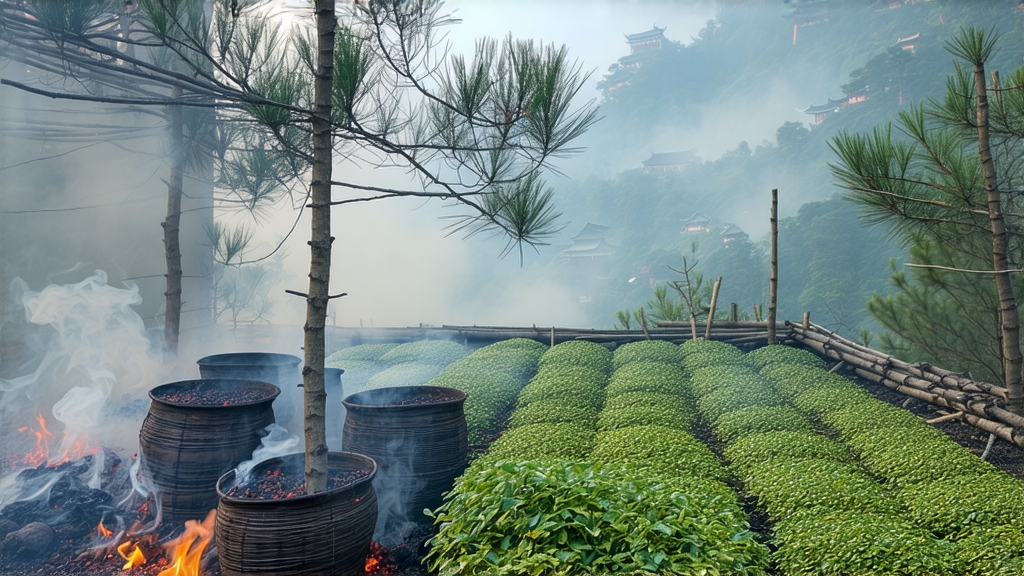
When European tea drinkers first encountered the dark, twisted leaves that brewed into a bright crimson liquor in the early seventeenth century, they were tasting Lapsang Souchong—long before the English gave the category the name “black tea.” Grown in the granite crevices of the Wuyi massif in northern Fujian, this pioneering red tea (hong cha) set the template for every malty Assam, every wine-like Keemun, and every brisk Ceylon that would later colonize morning tables from London to Kolkata. Yet its own story remains rooted in a single mist-locked valley where pine smoke once signaled both danger and discovery.
Legend places the birth of Lapsang Souchong during the late Ming dynasty, around 1646, when a Qing army column forced tea farmers to abandon their withering leaves. Returning after the soldiers passed, the growers found the leaves oxidized far past the intended green-tea stage. In desperation they dried the crop over fresh pinewood fires to accelerate finishing, and the accidental smoke infusion pleased the Dutch buyers waiting at Xiamen port. The new tea, called “Xiao Zhong” (“small sort”) to distinguish it from the coarser “Da Zhong” (“big sort”), sailed east as Bohea (Fujianese “Wuyi”) and ignited a fashion that would redraw global trade routes.
Today the protected geographical zone centers on Tongmu Guan, a village tucked so deep into the Wuyi Biosphere Reserve that unauthorized vehicles are barred. At 600–1,200 m elevation, the canyon traps humid air rising from the Jiuqu Xi River, creating a perpetual mist that slows photosynthesis and concentrates amino acids. The indigenous cultivars—Xingcun Xiaozhong, Wuyi Qizhong, and the scarce wild Zhenghe Da Bai—send roots into weathered granite rich in potassium and manganese, minerals that translate into a sweet, mineral finish beneath the smoke.
Two distinct styles now share the Lapsang name. The traditional “smoked” version, exported since the Qing, is crafted by laying partially oxidized leaves on bamboo trays above a pinewood hearth. The fire is fed with resinous Masson pine and local cedar; bark and needles are separated so that twigs smolder rather than flame, releasing a cool, aromatic smoke that drifts upward for eight to ten hours. Masters gauge readiness by scent alone: when the sharp top-note of creosote softens into a scent reminiscent of dried longan, the leaves are moved to a hot-air oven for final drying. In contrast, the “unsmoked” or “original” Tongmu Xiaozhong, beloved by modern Chinese gourmets, forgoes the pine step entirely, allowing the cultivar’s natural fruit and honey tones to dominate. Both styles share the same meticulous withering, rolling, and oxidation sequence, but diverge at the final act, creating siblings that share DNA yet speak different aromatic languages.
Craft begins around midnight, when dew-weighted shoots are carried into three-story wooden houses built on stilts. The ground-floor hearth is lit only after the top windows are unlatched; convection draws smoke upward, ensuring it caresses but never scorches the leaf. Withering lasts from 2 a.m. to 8 a.m., the leaves losing 60 % moisture while absorbing ambient resin. Rolling follows in narrow corridors where barefoot workers tread circular bamboo drums, breaking cell walls just enough to release enzymes that will oxidize catechins into theaflavins and thearubigins. Oxidation proceeds in cedar-lined chests kept at 24 °C and 85 % humidity; every fifteen minutes a master lifts a handful to the lamplight, watching for the coppery sheen that signals the leaf has crossed from green to red. Once the edges darken to mahogany, the smoking trays are loaded, and the final drying locks both flavor and folklore into every curl.
To brew Lapsang Souchong respectfully, treat it not as a blunt campfire but as a layered Burgundy. Use spring water at 90 °C—hotter water exaggerates tar, cooler flattens body. A 1:15 g-to-ml ratio in a thin-walled gaiwan allows smoke to lift off quickly, revealing sweeter strata beneath. Rinse once, then steep 5 s, 10 s, 15 s, adding 5 s each infusion; the first cup carries wisps of pine and wintergreen, the second introduces dried lychee and cacao, while the third slides